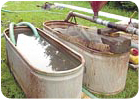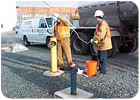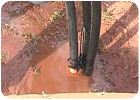
During drilling, a mud engineer should be present to monitor drilling-fluid viscosity and circulation pressure and to implement the procedures needed to minimize invasion of drilling fluid into the borehole wall and avoid causing fractures in the geologic material. With proper control, drilling mud should only penetrate the borehole to 0.25 inches, making subsequent well development relatively easy.

Residues from drilling fluids can alter sample chemistry. Potential effects on water chemistry from “pure” (unamended) bentonite result primarily in changes in the major ion chemistry of ground water from the well. If well development has insufficiently removed residues of bentonite-based drilling fluids, the exchange of cations in the clay matrix with possible organic and inorganic constituents occurring in ground water could result in data showing lower or higher constituent concentrations. Other effects of drilling-fluid contamination on ground water can be indicated by elevated concentrations of sulfate, chloride, phosphate and organic carbon; metals; absorbed organic compounds; an altered cation exchange capacity, pH and chemical oxidation demand. Polymeric drilling fluids contain organic compounds that enhance biologic degradation of the drilling fluid, but this biologic activity can cause long-term variations in the chemistry of ground water samples that could be difficult to reverse.

This article is provided through the courtesy of the U.S. Geological Survey. It is excerpted from Report 96-4233, “Selection and Installation of Wells, and Supporting Documentation,” written by Wayne Lapham, Franceska Wilde and Michael Koterba.


Report Abusive Comment